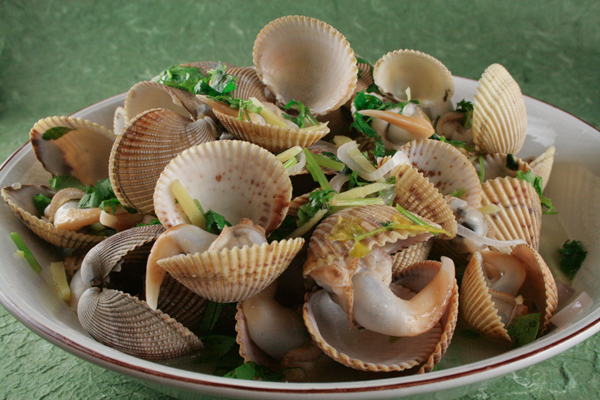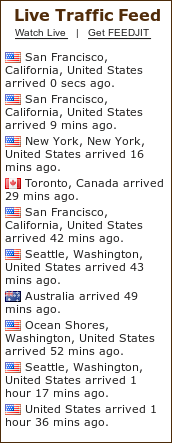Cockles and Mussels, Alive, Alive-O! — Pan-fried and Steamed Cockles, Fresh from Tillamook Bay
Oregon and Ireland have more than cockles and mussels in common. The winter skies are similarly gray and wet, and there are more hues of green in nature in Oregon and Ireland than you can imagine, even during the wintertime.
Another commonality: great seafood. If you like the outdoors, why go to a fishmonger? Catch it yourself! The jetties yield rockfish, the ocean harbors halibut and salmon, the rivers have steelhead, and the lakes are teaming with trout. And what about the bays? Well, besides the queen of crabs, the Dungeness, there are countless varieties of clams waiting for you. All you need to bring is a shellfish license and some garden tools: a shovel if you’re digging for clams and a garden rake to dig for cockles.
Since life in the ocean and bays ebbs and flows with the tides, the best time to dig for clams and cockles is during a minus or negative low tide. A series of minus tides this past weekend (-.75 ft on Sunday) meant that clamming enthusiasts were out in force, plus the fact that the low tide was at a reasonable 9:30 a.m.
Our destination was the town of Garibaldi at the northern edge of Tillamook Bay. A public-access fishing/crabbing pier off 12th street also has steps leading down to the bay. At a -.75 tide, the clam beds and cockle beds about 10 yards from shore were only knee-deep in water. By the time Charles and I got there, 20-30 people in boots, waders or shorts were roaming the clam beds, hunting for gapers, steamers and cockles.
We were there for the cockles. One of my favorite childhood food memories in Thailand and Singapore was eating steamed blood cockles. They’re called that because these little suckers have hemoglobin. I remember their sweet flavor, with just a hint of the sea they came from.
Before leaving for Garibaldi, I had consulted our intrepid Outdoors writer, Henry Miller, who was planning a razor clam expedition. When I asked him about cockles, he said all I needed was a rake. (He loaned me a 4-tine garden rake that was perfect for the job.) It turns out that hunting for cockles is as easy as running your rake through the sand until you hit something that feels like a rock, you pull it up through the water to wash away the sand, and voilà, there’s a cockle caught in your rake. What could be easier? In an hour and a half, Charles and I had our limit of cockles (20 each). We iced them down in our cooler and went in search of lunch before heading home (with a stopover to fish at Mt. Hebo Lake where I had reports of 12- to 14-inch rainbow trout from an office colleague).
By 3:30 p.m. I was happily napping in the van, dreaming about the 40 cockles and three 12- to 14-inch trout that we caught at Mt. Hebo Lake, as Charles drove us home. For some strange reason this song kept cycling in my dream:
In Dublin’s fair city, where the girls are so pretty
I first set my eyes on sweet Molly Malone
As she wheeled her wheel-barrow
Through streets broad and narrow
Crying cockles and mussels, alive, alive-O!
Alive, alive-O! alive, alive-O!
Crying cockles and mussels, alive, alive-O!
One of the things we always do with store-bought clams to purge them of sand is to soak them in a very large bowl filled with a salt-water solution and a few ice cubes to keep the water cold. We sprinkle corn meal in the water, and the clams will suck in the cornmeal and purge any sand that’s in their shells. We did the same with the cockles. The ratio is 1/3 cup salt to 1 gallon of water and we let them sit for an hour. If we had had more time, we would have let them sit another hour or two, as we found after cooking that a few cockles still had sand in them. Scrub and rinse the cockles in cold water after purging.
Pan-fried Cockles
- Pick the largest cockles for frying. Scrub them under cold running water and purge them of sand according to instructions above, reserve the largest ones and shell them using an oyster knife, prying them open near the hinge and then working your way around until you have the shells separated. Remove the cockles from their shells and set them aside in a bowl.
- Prepare an egg wash of 2 eggs and 1 cup (240 ml.) buttermilk, beaten together well.
- Prepare a batter mixture of 1 cup (240 ml.) flour, 1 cup (240 ml.) fine-ground cornmeal, and 1 cup (240 ml.) Progresso-seasoned Italian bread crumbs and mix well.
- Several cups (480-960 ml.) of canola oil for deep frying.
- Heat oil in a saucepan or heavy pan over medium-high heat.
- Working with 1 cockle at a time, coat it in the egg mixture, then dredge it in the flour mixture until it’s completely coated, give it another coat of egg mixture and one last dredge in the flour mixture, then fry in the oil.
- Turn the cockles in the oil after a couple of minutes to make sure they cook evenly, and remove after two or three minutes when golden brown. Do not overcook, or the cockles will become tough.
- Garnish with parsley and serve with cocktail or tartar sauce.
Cockles Steamed in Ginger Cilantro Broth
- 20-30 live cockles, purged, scrubbed and rinsed according to above instructions (you can substitute clams or mussels)
- 1/3 cup (80 ml.) dry white wine (we used Abacela Albariño)
- 3 cups (720 ml.) water
- 1 cup (240 ml.) chopped cilantro stems
- ¼ cup (60 ml.) chopped cilantro leaves (for garnish)
- 1 teaspoon (5 ml.) salt
- ¼ cup (60 ml.) ginger, peeled and cut into matchstick-thin slices
- 8 tablespoons (120 ml.) butter
- Melt butter in a large pot and sauté ginger and cilantro for a few minutes until fragrant.
- Add white wine and water and bring to a rapid boil.
- Add cockles and cover.
- After two or three minutes, the cockle shells will start to pop open. With a pair of tongs, remove the open cockles and place them into a serving bowl. Discard any cockles that do not open after about 4 minutes.
- Turn off the flame and, using a strainer lined with a paper towel, ladle some of the cooking liquid into the towel and strainer you’ve poised over the cockles in the serving bowl. The towel will trap any sand left in the cooking broth.
- Garnish the cockles with the chopped cilantro leaves and serve immediately.
Enjoy with a glass of dry white wine. We used Abacela Albariño.
— Vic
























You guys are adventurous. What envy I have for those fried cockles…licking my fingers.
Sounds to me like you two are having way way too much fun, but keep it up and enjoy life. Marlene
Hey Vic and Charles! I fried my cockles last night using your recipe. It was fantastic! I’ve never been comfortable frying food, but the coating had a wonderful flavor and crunch, and the double-dip technique was a revelation. The cockles were not greasy at all. My little shelled beauties looked exactly like those in the blog. Den loved them! Another successful dinner, thanks to The Taste of Oregon and the men behind it.
Dear Victor,
Just a short but hearty thank you note. I am a Brazilian 70 yrs old translator and was looking for the correct translation for “mussels steamed in a paper bag” when I ran into your article. Thank you so much for bringing me back many good memories with that lovely Irish song on cockles and mussels.
Carolina